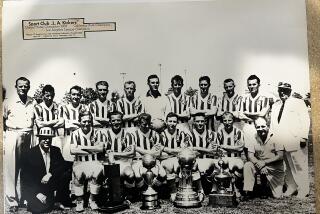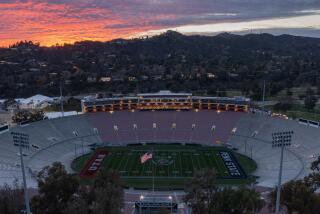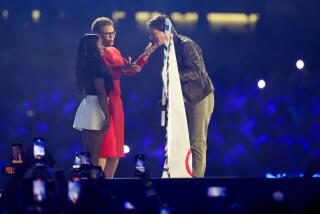Rose Bowl Gets Final of World Cup
ZURICH, Switzerland — The international soccer federation made it official here Monday, selecting Pasadena’s Rose Bowl as the site of the 1994 World Cup final and an unprecedented seven other games that organizers claim will bring $1 billion to the Los Angeles area from the United States’ first role as host country.
To win the plum matches of the 24-nation, monthlong tournament, Los Angeles promoters overcame concerns among members of soccer’s international governing board, Federation Internationale de Football Assn. (FIFA), about the recent riots.
“The riots generated some questions on the site selection committee,” said Alan Rothenberg, a Los Angeles lawyer who is president of the U.S. Soccer Federation. “But they also created an attitude in Los Angeles to show the world that L.A. was still a great city and put it back on the map.”
In the end, said FIFA executives, it was the successful handling of the 1984 Olympics in Los Angeles and the 102,000-seat capacity of the Rose Bowl, largest by far of all the stadiums proposed, that convinced the FIFA committee.
Members of the international soccer federation remain worried about the ability of the United States to build enthusiasm for what has been historically a European and South American sport. Although an estimated 16 million play organized soccer in the United States, it has never developed the significant following it enjoys overseas.
But FIFA’s president, Joao Havelange of Brazil, said he was impressed by the huge crowds drawn to the Rose Bowl for soccer during the 1984 Olympics.
“I don’t think it is a risk,” he said. “I sensed the enthusiasm when I was there at the Olympics in 1984.”
During the 1984 Olympics, crowds for three of the 11 games played at the Rose Bowl drew the largest crowds ever to attend soccer matches in the United States.
Except for 1974 World Cup final in Munich, all the rest of the World Cup final matches have been played in the host nation’s capital. But Washington’s Robert F. Kennedy stadium, with a seating capacity of 56,500, was deemed too small for the world’s most-watched single sporting event, seen by a television audience of more than 1.5 billion, seven times the size of a Super Bowl audience.
An attempt by some Washington civic leaders to construct a new stadium fizzled, leaving the Rose Bowl and Miami’s Joe Robbie Stadium as the leading contenders. The Miami stadium, favored by several selection committee members, was eliminated because of potential scheduling conflicts with the city’s new National League baseball expansion club, which will play there.
“I am convinced that the 1994 World Cup in the United States will be a historic time for the international game of (soccer),” Joseph S. Blatter, FIFA general secretary, said in announcing the site selections.
As expected, Blatter named Chicago’s Soldier Field as the site for the opening ceremony and first game June 17, 1994. Defending champion Germany will play an opponent picked in the draw of opponents.
Besides Los Angeles and Chicago, seven other cities will hold four games during the first round, which will be double elimination. The stadiums selected are the Silverdome in Pontiac, Mich., the first indoor facility to be used in World Cup competition; RFK in Washington; Stanford Stadium in Palo Alto; the Citrus Bowl in Orlando, Fla.; Giants Stadium in East Rutherford, N.J.; Foxboro Stadium near Boston, and the Cotton Bowl in Dallas.
For the second round of 16 teams--single elimination--the Silverdome will not be used, primarily because officials are worried about the ability of the stadium’s experimental natural grass surface to hold up under the wear and tear. FIFA rules require that World Cup matches be played on grass, requiring the removal of synthetic surfaces in Detroit, Dallas and New Jersey.
Blatter said the site selections were contingent on stadium authorities making changes required by FIFA inspectors. Besides the conversions from artificial to natural surfaces, the changes include widening fields to the 68 meters required by the federation. Ross Berlin, vice president for sites of World Cup ‘94, said changes required at the Rose Bowl include widening of the playing surface and “buffer zones.” Improvements also must be made to locker rooms, concessions and restrooms.
Quarterfinal matches are planned in Foxboro, Dallas, East Rutherford and Palo Alto. The Rose Bowl and Giants Stadium were picked for the semifinal games, and the Rose Bowl will also have the third-place game, giving the Pasadena stadium an unprecedented eight games, four in the tournament’s final 10 days.
“Everyone at the World Cup is especially pleased that FIFA favorably viewed our plans for a unique soccer festival in conjunction with the World Cup final,” Rothenberg said. “As the tournament moves to its conclusion, fans, media, the whole soccer family will join together in Los Angeles to witness a semifinal, the third-place match and the final amidst the greatest celebration of soccer that has ever been seen.”
At a news conference Monday at a Zurich hotel, Managing Director Scott LeTellier of World Cup ’94 also unveiled a new World Cup ticket system.
Supporters of any national team will be able to order tickets enabling them to follow their team wherever it travels throughout the tournament. Also, residents of host cities will be given opportunities to buy tickets for all games in their locations, LeTellier said.






